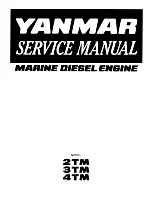
Component description
Group 30: Electrical system
14
Injectors
The injectors are installed on the cylinder head.
The amount of fuel injected and injection duration is
controlled by the engine control unit, via electromag-
netically controlled fuel valves in the injectors. This
means that the engine always receives the correct
volume of fuel in all operating conditions, which offers
lower fuel consumption, minimal exhaust emissions
etc.
Speed sensor, crankshaft
The engine speed sensor is an inductive sensor.
When the crankshaft rotates impulses are created in
the sensor via a tooth wheel on or behind the torsion
damper. The impulses create a pulse signal in the
sensor that the engine control unit (EMS 2) uses to
calculate the crankshaft’s rpm.
The tooth wheel has a tooth free gap for the EMS 2 to
recognize the crankshafts position.
The signal is sent to the engine control unit, which
calculates the injection in advance and the amount of
fuel to be injected.
Speed sensor, camshaft (cam-
shaft position)
The camshaft sensor is an inductive sensor. When
the camshaft rotates impulses are created in the sen-
sor via a tooth wheel installed on the camshaft. The
tooth has seven teeth, one for each cylinder and one
to determine when cylinder one is to be injected. The
impulses create a pulse signal in the sensor that the
engine control unit (EMS 2) uses to calculate when a
cylinder is in turn for injection.
















































